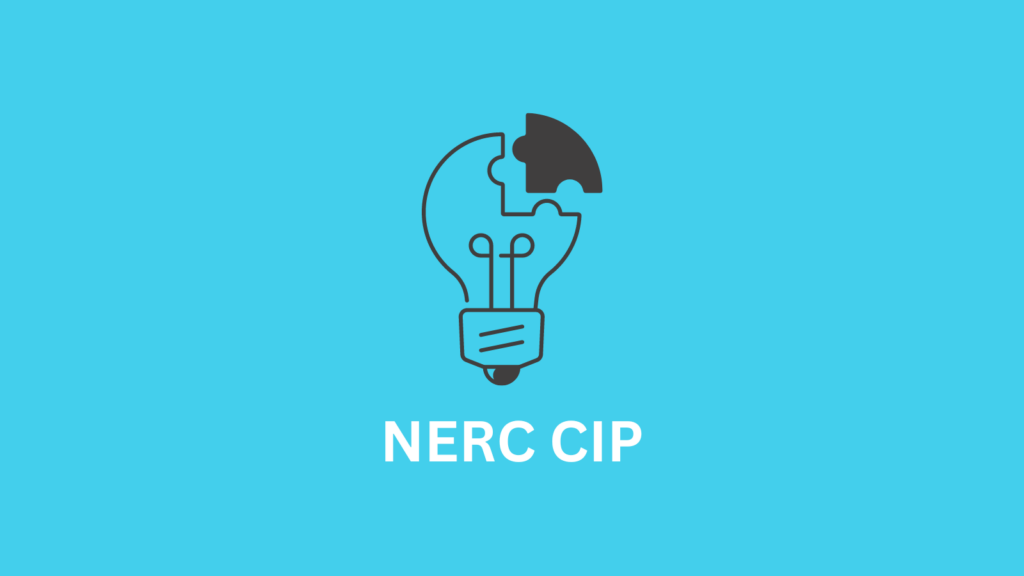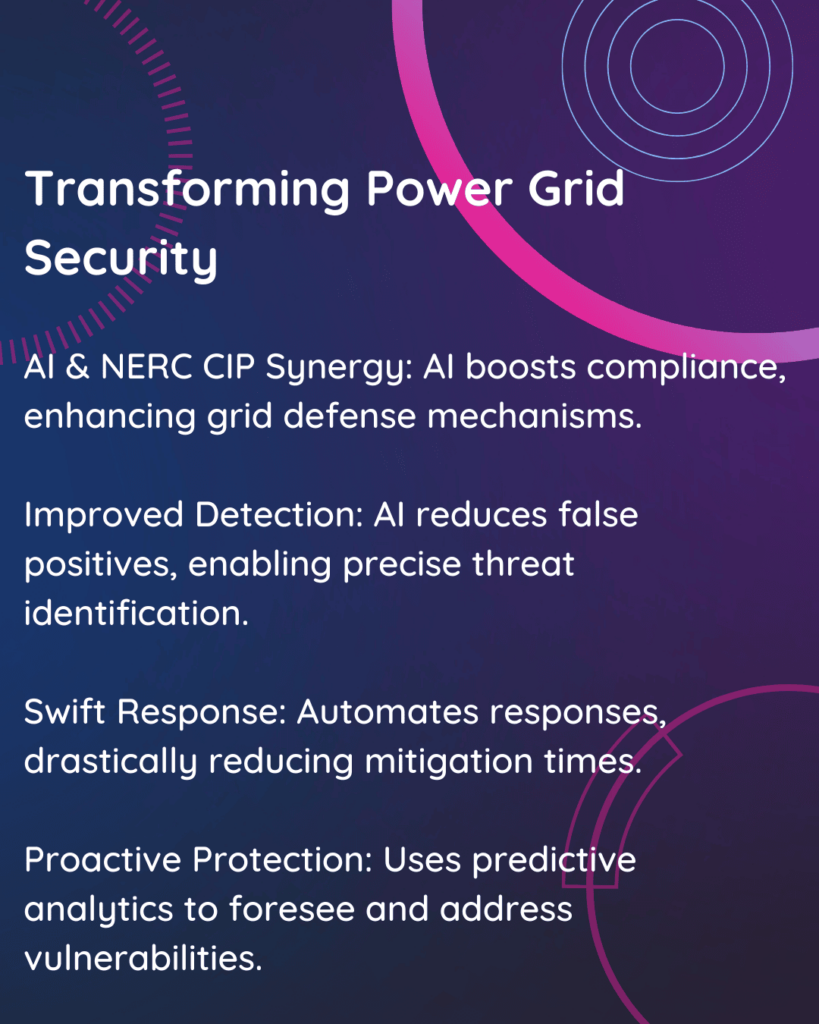NERC CIP and Artificial Intelligence: Enhancing Security with Advanced Technologies
Today, where technology evolves at lightning speed, the energy sector faces a critical challenge: keeping the power grid safe from cyber threats. For those of us in the industry, the importance of safeguarding our infrastructure cannot be overstated.
It’s not just about compliance; it’s about ensuring that every home, business, and community continues to enjoy reliable electricity without interruption. This is where the North American Electric Reliability Corporation Critical Infrastructure Protection (NERC CIP) standards come into play, setting the bar for security across the board.
However, as cyber threats become more sophisticated, meeting these standards has turned into a complex task. Traditional security measures are no longer enough. This is where Artificial Intelligence (AI) steps in, offering a beacon of hope.
AI isn’t just a buzzword; it’s a powerful tool that can transform how we protect our power grids. From detecting anomalies that hint at a cyberattack to automating responses to security incidents, AI is revolutionizing the way we approach grid security.
But how exactly does AI fit into the NERC CIP framework? And more importantly, how can it make compliance not just achievable but more efficient? If you’re looking for ways to enhance your grid’s security posture while navigating the intricate landscape of NERC CIP compliance, you’re in the right place.
In this article, we’ll explore the dynamic duo of NERC CIP and Artificial Intelligence. We’ll dive into how AI can not only help meet compliance requirements but also significantly bolster our defenses against cyber threats. Let’s see how advanced technologies are shaping the future of grid security, making it smarter, more resilient, and ready to face the challenges of tomorrow.
Chapters
- Comprender el NERC CIP:
- La intersección de los estándares NERC CIP y la IA en la seguridad de la red eléctrica:
- Soluciones impulsadas por IA para el cumplimiento de NERC CIP:
- Estudios de caso: IA en acción dentro de entornos compatibles con NERC CIP
- Mejores prácticas y lecciones aprendidas:
- Desafíos y consideraciones al integrar la IA con los marcos NERC CIP
- El futuro de la IA en el cumplimiento de NERC CIP y la seguridad de la red eléctrica
- Tendencias y tecnologías emergentes
- FAQs
Understanding NERC CIP:

NERC CIP stands for North American Electric Reliability Corporation Critical Infrastructure Protection. It is a set of requirements designed to secure the assets required for operating North America’s bulk electric system. The NERC CIP standards aim to protect the critical infrastructure of the electric utility industry from potential cybersecurity threats and vulnerabilities that could affect the reliability and safety of the electricity supply.
The standards cover a wide range of security protocols, including physical security of the facilities, cybersecurity of the networks and information systems, personnel and training, incident reporting and response planning, and recovery plans to restore reliable operations after a cyberattack.
Adhering to NERC CIP standards is a complex task, demanding a thorough grasp of intricate technical and regulatory details. The critical nature of electrical infrastructure, coupled with the evolving landscape of cyber threats, underscores the necessity for specialized expertise. Such professionals are pivotal in steering through compliance requirements, fortifying cybersecurity programs against emerging threats.
Continuous system maintenance and vigilant monitoring are essential to preemptively address potential security breaches. This proactive approach, guided by NERC CIP standards, is crucial in ensuring the bulk electric system’s reliability and security. Non-compliance carries hefty penalties, with fines potentially reaching up to $1 million per day for violations. Thus, leveraging expert guidance and implementing cutting-edge cybersecurity strategies are imperative for mitigating cyber risks effectively.
The Intersection of NERC CIP Standards and AI in Power Grid Security:
AI technologies not only align with but significantly enhance NERC CIP compliance efforts, offering a more dynamic and effective defense mechanism against cyber threats. By combining compliance and technology, utilities can leverage AI to enhance threat detection accuracy by up to 90%, improving their overall security posture and staying ahead of evolving cyber risks.
AI’s ability to adapt and respond to sophisticated and dynamic cyber threats within milliseconds sets it apart from traditional rule-based approaches, providing a proactive and agile security solution that complements the rigorous requirements of NERC CIP standards.
| Aspect | Traditional Compliance | AI-Enhanced Compliance |
| Efficiency | Time-consuming and labor-intensive | Highly efficient and less resource-intensive |
| Accuracy | Prone to human error | High accuracy with machine precision |
| Adaptability | Slow to adapt to new threats | Rapid adaptation to evolving cyber threats |
| Proactivity | Reactive approach | Proactive threat anticipation and mitigation |
AI-Driven Solutions for NERC CIP Compliance:
AI-driven solutions are setting new benchmarks in compliance and security, from advanced monitoring to predictive analytics. Let’s explore these solutions and their impact on the energy sector.
Advanced Monitoring and Detection:
AI-powered monitoring tools have proven to be game-changers in threat detection. By leveraging machine learning algorithms and advanced analytics, these solutions can identify and flag potential threats with unparalleled accuracy. According to industry reports, AI-powered monitoring tools can reduce false positives by 70%, enabling focused response efforts and minimizing the risk of overlooking critical security incidents.
Predictive Analytics for Vulnerability Management:
- One of AI’s most significant contributions to NERC CIP compliance is its ability to predict and mitigate potential vulnerabilities proactively.
- Through predictive analytics, AI systems can analyze vast amounts of data, including network traffic patterns, system logs, and threat intelligence, to identify potential weaknesses before they can be exploited.
- This proactive approach can decrease vulnerability resolution time by 50%, preempting potential breaches and minimizing the risk of non-compliance with NERC CIP standards.

Automated Incident Response:
In the event of a cybersecurity incident, time is of the essence. AI-driven automation can significantly improve incident response times and decision-making processes, minimizing the potential impact on grid operations. By automating certain response tasks, such as threat containment, data collection, and initial triage, utilities can cut incident response times by 80%, ensuring swift and effective mitigation efforts while adhering to NERC CIP compliance requirements.
Case Studies: AI in Action within NERC CIP Compliant Environments
The theoretical benefits of AI in NERC CIP compliance are compelling, but the true measure of these technologies lies in their real-world application. Through case studies, we will examine how utilities are leveraging AI to not only meet but exceed NERC CIP standards, significantly reducing cybersecurity incidents and enhancing grid reliability.
Real-World Applications:
One major utility company implemented an AI-driven security solution to bolster its NERC CIP compliance efforts. By integrating advanced threat detection and predictive analytics capabilities, the utility reported a 60% reduction in cybersecurity incidents within the first year of deployment. This remarkable improvement showcases the tangible benefits of AI in fortifying power grid security and meeting NERC CIP requirements.
Best Practices and Lessons Learned:
As more utilities explore integrating AI into their NERC CIP compliance strategies, industry experts have identified several best practices and lessons learned. One crucial aspect is the need for a comprehensive data strategy, ensuring that AI systems have access to high-quality, relevant data for effective decision-making.
Additionally, utilities must prioritize the security and reliability of their AI systems, implementing robust testing and validation processes to maintain the integrity of these critical technologies. By embracing these best practices, utilities have reported a 30% increase in overall grid security effectiveness, setting new industry benchmarks for NERC CIP compliance.
Challenges and Considerations in Integrating AI with NERC CIP Frameworks
While the benefits of AI in NERC CIP compliance are undeniable, it’s essential to address the challenges and considerations that accompany the integration of these advanced technologies into existing infrastructures.
Integration Complexities:
One of the primary hurdles utilities face is the complexity of integrating AI systems with their existing infrastructure and processes. Seamless integration requires careful planning, extensive testing, and close collaboration between IT teams, cybersecurity experts, and AI solution providers. Utilities must also navigate the intricate web of NERC CIP requirements, ensuring that their AI deployments align with these standards from the outset.
Ensuring AI System Reliability and Security:
As AI systems become integral components of critical infrastructure security, ensuring their reliability and security is paramount. Utilities must implement robust validation processes, continuous monitoring, and rigorous testing to prevent potential vulnerabilities or unintended consequences.
Additionally, measures must be taken to protect AI systems from adversarial attacks, such as data poisoning or model evasion, which could compromise their effectiveness and compromise NERC CIP compliance efforts.
Navigating Legal and Regulatory Landscapes:
The deployment of AI technologies in the energy sector is subject to a complex web of legal and regulatory considerations. Utilities must navigate data privacy regulations, intellectual property rights, and potential liability issues associated with AI decision-making.
Close collaboration with legal experts and regulatory bodies is essential to ensure compliance with relevant laws and regulations. While also fostering an environment that encourages innovation and the responsible use of AI in critical infrastructure protection.
The Future of AI in NERC CIP Compliance and Power Grid Security

As AI technologies continue to evolve, their potential to revolutionize NERC CIP compliance and power grid security grows exponentially. Emerging trends and technologies, such as explainable AI, federated learning, and advanced reinforcement learning techniques, hold immense promise for further enhancing grid security and compliance.
Emerging Trends and Technologies
Explainable AI addresses the “black box” challenge by providing transparent and interpretable decision-making processes. This transparency can be invaluable in demonstrating compliance with NERC CIP standards and fostering trust in AI-driven security solutions. Federated learning enables decentralized model training, allowing utilities to collaborate and share insights while preserving data privacy and confidentiality.
FAQs
How can small utilities comply with NERC CIP effectively?
Small utilities can streamline NERC CIP compliance by focusing on critical assets, utilizing compliance software, and seeking specialized cybersecurity partnerships for expertise and support.
What are common challenges in NERC CIP compliance?
Key challenges include keeping up with regulatory updates, managing extensive documentation, and ensuring ongoing staff training. Solutions involve integrating compliance into daily operations, using software for documentation management, and regular training updates.
How does AI improve NERC CIP security measures?
AI enhances NERC CIP security by offering advanced threat detection, predictive vulnerability analytics, and swift automated responses, leading to more effective and efficient compliance and protection strategies.
What is NERC CIP?
NERC CIP stands for North American Electric Reliability Corporation Critical Infrastructure Protection. It comprises a set of requirements designed to secure the assets required for operating North America’s bulk electric system.
Why was NERC CIP developed?
NERC CIP was developed to enhance the reliability and security of the bulk electric system by establishing standards that protect against potential cybersecurity threats and vulnerabilities that could lead to undesirable outcomes like power outages or grid failures.
What entities are required to comply with NERC CIP standards?
Entities required to comply with NERC CIP standards include electricity suppliers, grid operators, and other organizations that are part of the North American bulk electric system.
How many NERC CIP standards are there?
There are currently 11 standards, numbered CIP-002 through CIP-013, each addressing different aspects of cybersecurity and physical security within the bulk electric system.
What does NERC CIP-007 specifically address?
NERC CIP-007 deals with systems security management. It outlines requirements for managing security controls related to system security, including the implementation of malware prevention, security patch management, and the management of ports and services.
How does an organization become NERC CIP compliant?
Compliance involves conducting regular risk assessments, implementing security measures that meet or exceed NERC CIP standards, maintaining proper documentation, and undergoing regular audits by NERC-certified auditors.
What are the penalties for non-compliance with NERC CIP?
Penalties can be severe, including fines of up to $1 million per day per violation, depending on the severity and duration of the non-compliance.
How does NERC CIP impact cybersecurity?
NERC CIP directly impacts cybersecurity by requiring entities to implement specific security measures, perform regular vulnerability assessments, and respond promptly to potential cybersecurity threats.
What role does physical security play in NERC CIP compliance?
Physical security is crucial as it protects critical cyber assets from physical actions and events that could potentially cause harm or disruption to the bulk electric system.
Can NERC CIP standards evolve over time?
Yes, NERC CIP standards are periodically reviewed and updated to address emerging threats, technological advancements, and changes in industry practices to ensure continued protection of the bulk electric system.
What is a NERC CIP audit?
A NERC CIP audit is an evaluation performed to ensure that entities are complying with NERC CIP regulations. These audits can be conducted on-site or remotely and are performed by NERC-certified auditors.
What is the difference between NERC CIP and NIST frameworks?
While NERC CIP is specific to the North American bulk electric system and focuses on compliance, NIST (National Institute of Standards and Technology) frameworks provide broader guidelines that can be applied to various industries for improving cybersecurity and risk management.
How frequently must NERC CIP compliance be reported?
Entities must report compliance at least once every calendar year, although more frequent reporting may be necessary if potential compliance issues or system changes occur.
What are the cybersecurity training requirements under NERC CIP?
NERC CIP requires relevant personnel to undergo specific training on cybersecurity awareness and the security procedures specific to their role at least annually to ensure they understand and can effectively contribute to the security of the bulk electric system.
How do NERC CIP requirements address incident response and recovery?
NERC CIP requires entities to have documented incident response plans that include processes for classifying, responding to, and recovering from cybersecurity incidents to minimize impacts on the reliability of the bulk electric system.
What is NERC CIP-014 and its importance?
NERC CIP-014 addresses the physical security of particularly critical transmission stations and substations, and their associated primary control centers, to ensure they are protected against physical attacks that could impact the grid’s reliability.
How do entities manage vendor risk under NERC CIP?
Under standards like NERC CIP-013, entities are required to manage cybersecurity risks associated with the supply chain for bulk electric system assets, including vendor risk management and the security of remote access software.
What documentation is required for NERC CIP compliance?
Required documentation includes risk assessments, security policies, training records, incident response plans, and audit logs, all demonstrating adherence to the NERC CIP standards.
What are the challenges of implementing NERC CIP standards?
Challenges include the complexity of the regulations, the need for continuous technological and procedural updates, resource allocation, and ensuring that all staff are adequately trained and compliant.
What resources are available to help with NERC CIP compliance?
Resources include guidance documents from NERC, consultancy services specializing in NERC CIP compliance, training programs, and compliance software tools that help entities meet NERC CIP requirements.
Create more and better content
Check out the following resources and Grow!